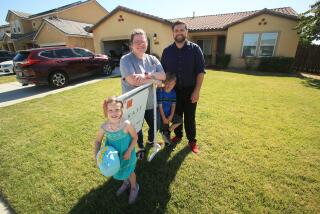Speculators drive up defaults, report says
Blame it on the speculators.
That’s what the Mortgage Bankers Assn. did Thursday in a report showing that as many as 1 in 5 mortgages in default in California belongs to borrowers who are not living in the homes with the troubled loans.
The numbers were worse in Nevada, Arizona and Florida, where one-quarter to one-third of defaults as of June 30 were tied to investor loans, the Washington-based trade group said.
Mortgage bankers are coming under increasing fire for their role in pushing high-cost adjustable-rate loans on homeowners during the recent housing boom. But now with the housing market in the doldrums, a growing number of borrowers are unable to make their monthly mortgage payments and are falling into foreclosure.
This rapid rise in delinquencies has prompted some members of Congress and consumer advocates to urge tighter regulation of the mortgage industry and aid for borrowers on the verge of losing their homes.
But the mortgage bankers group suggests that some of these borrowers might not deserve to be saved.
Many of the vacant, foreclosed homes dotting neighborhoods these days were bought by speculators who intended to “flip” their real estate investments for a quick profit but couldn’t once the housing market slowed, said Doug Duncan, the trade group’s chief economist.
“Defaults are on the rise in most parts of the country, but it should be recognized that it is not always the case of a homeowner losing his or her home but is often the case of an investor gambling on a continued increase in home values and losing that gamble,” Duncan said.
Many of these investors “simply walked away from the mortgages,” he said.
The trade group defines “defaulted mortgages” as those 90 days or more past due or in foreclosure.
More evidence piled up Thursday underscoring the growing weakness in the nation’s housing market. A key federal housing agency said that U.S. home prices in the second quarter rose at their slowest annual pace in a decade.
U.S. average house prices rose 3.2% from the same period a year earlier, the Office of Federal Housing Enterprise Oversight said. Compared with the first quarter of 2007, house prices edged up 0.1%, the smallest increase since late 1994.
In California, prices fell 1.4% year over year, the agency said.
The federal home-price index tracks average house price changes in repeat sales or refinances of the same single-family houses. The agency, however, follows only those sales financed with so-called conforming loans, or loans for less than $417,000.
That’s why Thursday’s data varied somewhat from another national home-price index released this week that found U.S. home prices actually fell 3.2% in the second quarter.
That index, by S&P;/Case-Shiller, includes repeat sales involving both conforming and nonconforming, or “jumbo,” mortgages.
The discrepancy between the indexes “indicates that prices of houses financed with jumbo loans or sub-prime loans are dropping much more than houses financed with conforming loans,” said Patrick Newport, an economist with research firm Global Insight Inc.
Nonetheless, Newport wrote in a report to clients that he expected the federal home-price index to turn negative later this year.
More to Read
Inside the business of entertainment
The Wide Shot brings you news, analysis and insights on everything from streaming wars to production — and what it all means for the future.
You may occasionally receive promotional content from the Los Angeles Times.










